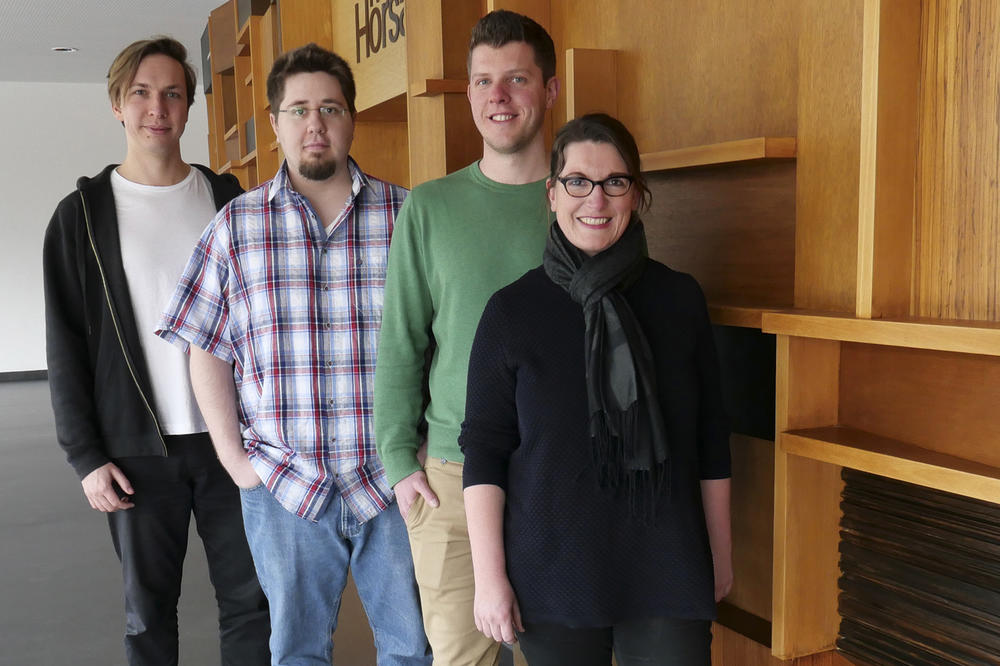A Surfboard for Cells
A junior research group led by chemist Marie Weinhart developed a biomaterial for coating Petri dishes. They can use it to harvest cell cultures so gently that they can be used for the production of artificial 3D tissue.
Apr 24, 2019
Oliver Etzold, Simon Rackow, Daniel Stöbener, and Professor Marie Weinhart (from left to right) are working on a thermoresponsive coating for Petri dishes.
Image Credit: Marion Kuka
While working on her doctoral thesis at Freie Universität, chemist Marie Weinhart discovered a material on which cells can surf. Weinhart published her dissertation in 2011, and started her own junior research group Surf3DTiss, funded by the German Federal Ministry of Education and Research, where she worked on using the polymer to assist in the production of three-dimensional artificial tissue. This new approach called “cell sheet engineering” was developed in Japan. In this method, the natural framework of cells, called extracellular matrix (ECM), is used to construct 3D tissue. The ECM is produced by the cells themselves as soon as they adhere to a substrate such as a Petri dish. However, using conventional harvesting methods, the tissue is often damaged during removal.
Suitable for Production of Artificial 3D Tissue
The junior research group led by Marie Weinhart developed a coating for Petri dishes from a polymer, which changes its physical properties by lowering the ambient temperature below 37 degrees and suddenly exhibits a cell-repellant effect. As a result, the two-dimensional cell layer is released from the surface along with the produced ECM and can be used largely undamaged. The harvested cell layers with intact ECM can be used particularly well in medicine for the regeneration of organs or for the production of artificial 3D tissue.
Oliver Etzold and Simon Rackow did research in Marie Weinhart’s group while working on their master’s theses, and Daniel Stöbener did research for his doctoral thesis in this group. With guidance from the chemist, they tested the coating under many different conditions in order to resolve open questions. “That was exciting because the new material can solve a very real problem,” said Simon Rackow. It was beneficial that the research group consists of scientists from the fields of biology and biotechnology and cooperates with research groups working in medical technology and biotechnology.
Image at left: Removal of a “cell sheet” from a thermo-responsive Petri dish after lowering the temperature from 37° C to 20° C. The 2D cell monolayer begins to detach from the edge after 10 minutes (a). After 20 minutes it is largely separated from the substrate (b), and after 30 minutes it floats completely detached in the Petri dish (c). The harvested “cell sheet” can now be used as a 2D building block for the construction of 3D tissue.
“We learned from our cooperation partners that there is a great demand for a thermo-responsive coating,” says Daniel Stöbener. Although products made of other materials are already on the market, there is still a need for new products. That is why the team decided to found a start-up called CellSurf. Along with their mentor Marie Weinhart, they have already achieved the proof of concept (experimental proof that the method works). It remains to be seen, whether the coating will work reliably even when produced in large quantities and after a long storage period.
Prototype Should Be Ready by Summer
Since January 2019, each of the three team members has been receiving a Berliner Startup scholarship at Freie Universität. By June, they expect to have a prototype ready for industrial production. Then they want to get feedback from partners and potential customers. At the moment Oliver Etzold says he doesn’t yet think much about what it feels like to be an entrepreneur. He spends part of his time in the same lab where he did research for his master’s thesis. But when he visits the office of the team in Freie Universität Berlin’s start-up incubator on Altensteinstraße 40, he starts to feel like a company founder. “The atmosphere there is great! We can get advice and exchange ideas with other start-ups.” That is another reason why he is convinced that the research findings will soon become a marketable product.
Further Information
Berliner Startup Stipendium
With the Berliner Startup Stipendium, Freie Universität Berlin, Technische Universität Berlin, Charité – Universitätsmedizin Berlin, and Humboldt-Universität zu Berlin are promoting founders who want to implement innovative and/or technology-based business ideas in a team. The program is funded by the Senate Department for Economics, Energy and Public Enterprises as well as the European Social Fund. Two to four scholarships of 2,000 euros per month over a period of six months can be awarded per start-up team. An extension of six months is possible under certain conditions.
Research to Market Challenge Competition
The “Research to Market Challenge” is a competition for research-based product and business ideas from Freie Universität Berlin, Humboldt-Universität zu Berlin, Technische Universität Berlin, and Charité – Universitätsmedizin Berlin. It is hosted by these universities in cooperation with Stiftung Charité, Ernst Reuter Gesellschaft, Humboldt-Universitäts-Gesellschaft and Berliner Sparkasse.
In a two-stage competition, members and alumni of the participating organizations can put their ideas on paper in German or English, submit them as a competition entry, and develop a plan for the first steps of implementation. The prizes include an opportunity to participate in a business model workshop and a total of 9,000 euros in prize money.
For the next round of applications, ideas can be submitted in the categories Digital & Technologies, Life Sciences & Health, or Cultural & Social until May 5, 2019.


